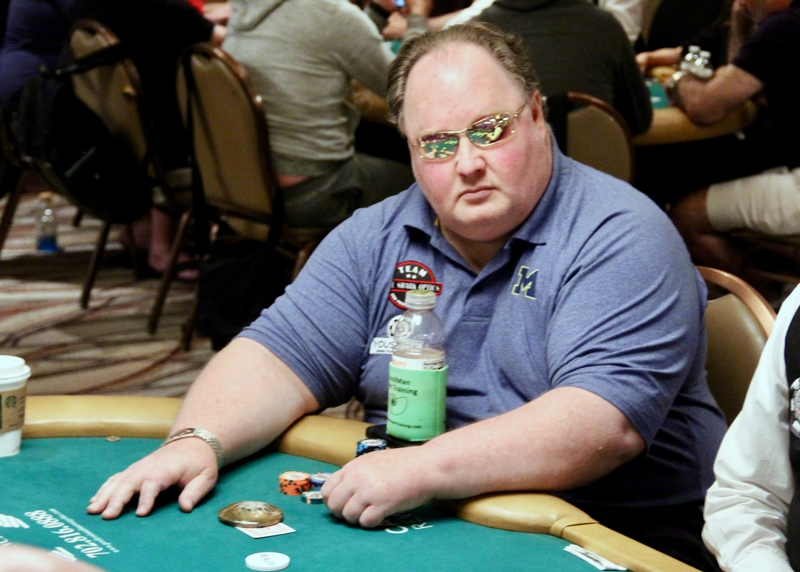






Winning Hands: Calling Shoves From The Big Blindby Greg Raymer | Published: Jun 18, 2023 |
|
|
 Please let me encourage you to reach out to me with article ideas and questions for future columns. You can tweet to me at
Please let me encourage you to reach out to me with article ideas and questions for future columns. You can tweet to me at @FossilMan, or send me a message at info@fossilmanpoker.com.
In 2019, I published FossilMan’s Winning Tournament Strategies, a 42-chapter book covering all the basic concepts behind being a winning tournament player, as well as many of the more advanced strategies.
For my next book, I will go through several dozen hands I have played and break down each decision along the way. Although not yet finished, I thought it would be fun to provide excerpts of some of those hands here for Card Player readers.
In this hand, we rewind nearly two decades to the $2,000,000 winner-take-all 2004 WSOP Tournament of Champions. We were down to five players and the blinds were 12,000-24,000 with a 4,000 ante. I was down to just over 200,000, or about eight big blinds.
It folded to me in the small blind, and I moved all in with 10 9
9 . Annie Duke was the big blind, and called with 8
. Annie Duke was the big blind, and called with 8 8
8 . The board ran out A
. The board ran out A 3
3 6
6 7
7 A
A , and I was eliminated in fifth place.
, and I was eliminated in fifth place.
Now, what is so interesting about this hand? Here, we simply apply a standard stack size strategy. I am down to just over eight big blinds, and it folds to me in the small blind. There is no hand with which I am going to do anything other than raise all in.
There may be some exceptions to this, however. Those exceptions only exist if you believe the player in the big blind is going to call with any two cards, or close to it. If you somehow know they are going to call pretty much every time (like 90%+), then you can correctly fold only your very worst hands.
In my experience, most players are actually much too tight when it comes to calling a short stack shove out of the big blind. In 2004 that was especially true. Sometimes you would see a player shove from the small blind for only three or four blinds, and the big blind would fold a fairly good hand. I used to even see bad players fold a hand as strong as A-10 offsuit in the big blind for a small all-in raise like this.
In today’s poker world, you would expect to always get called for only three or four blinds, but once we start getting to six or more blinds, many players still fold much too often. Because of this, unless you know the player in the big blind, you should assume they too will fold often, and go all-in with any two cards.
In this case, with 10-9 offsuit and eight blinds, I can go all in no matter how the opponent plays. In fact, this is what is known as an Unexploitable Shove.
If I were to go all in and turn over my cards, my opponent would be able to play perfectly. They would fold all worse hands, and call with all better hands. This would lead to them calling about 58% of the time.
Of the 42% they fold, I win their big blind and the antes, and my stack size increases to about 245,000. When they call, the pot size is 445,000, and they are almost a 60:40 favorite to win. This means I will win, on average, about 175,000 from this pot every time I shove.
So 58% of the time they call, and my average stack is 175K, and 42% of the time they fold, and my stack size is 245,000. Adding this up, when I shove, my average result will be a stack of 203,000. If I fold instead, my chip count is about 190,000.
Shoving is clearly better than folding.
All the analysis above assumes they will call or fold perfectly. But of course, they will never be able to play this perfect. They will not know to call with J-2 offsuit and fold 10-8 suited, for example. And most players will not call with anything near 58% of their hands, let alone the correct assortment.
In fact, I would guess that most players, for eight big blinds, will only call with somewhere between 15-30% of their hands. If they are folding this often, then you should be going all in with any two cards, and look forward to making a profit by doing so.
What about a third option, such as calling, or raising less than all in? For some very specific opponents one of these third options might have more value. However, this hypothetical opponent would have to be extremely transparent and easy to read after the flop, such that you could almost always make a perfect decision as to when to check-fold, when to bluff, and when to bet for value. Such opponents are one in a million, so realistically, forget about any third options.
Have fun, and play smart! ♠
Greg Raymer is the 2004 World Series of Poker main event champion, winner of numerous major titles, and has more than $7 million in earnings. He is the author of FossilMan’s Winning Tournament Strategies, available from D&B Publishing, Amazon, and other retailers. He is sponsored by Blue Shark Optics, YouStake, and ShareMyPair. To contact Greg please tweet @FossilMan or visit his website.